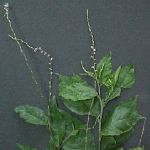| Common Name: |
Guinea Hen Weed |
| Other Names: |
Conga Root, Strong Man's Weed |
| Botanical Name: |
Petiveria alliacea |
| Genus: |
Petiveria |
| Family: |
Phytolaccaceae |
| Cultivation: |
Rich, moist soil in partial shade. |
| Native Location: |
S USA to Argentina and the West Indies |
| Propagation: |
By seed sown when ripe; by semi-ripe cuttings during the growing season. |
| Harvest: |
Whole plants, leaves, and roots are collected for use in decoctions. Fresh leaves are bound around the head for headaches or juiced for direct application for earache. |
| Height: |
1m (3ft) |
| Width: |
30-60cm (1-2ft) |
| Hardiness: |
Min. 10°C (50°F) |
| Parts Used: |
Whole plant, leaves, roots |
| Properties: |
A pungent, diuretic, antiseptic herb the reputedly calms the nerves, controls diarrhea, lowers fever, stimulates the uterus, and relaxes spasms. |
| Medicinal Uses: |
Internally for nervous spasms, paralysis, hysteria, asthma, whooping cough, pneumonia, bronchitis, hoarseness, fevers, headaches, influenza, cystitis, venereal disease, and menstrual complaints; also to induce abortion. Combined with Eryngium foetidum (See, culantro) for fevers. Seeped in rum as an aphrodisiac (Carribean). Externally for earache, fever, skin eruptions, toothache, and headache. |
| Bibliography: |
Encyclopedia of Herbs by Deni Brown Copyright © 1995, 2001 Dorling Kindersley Limited. pp 309-310 |

